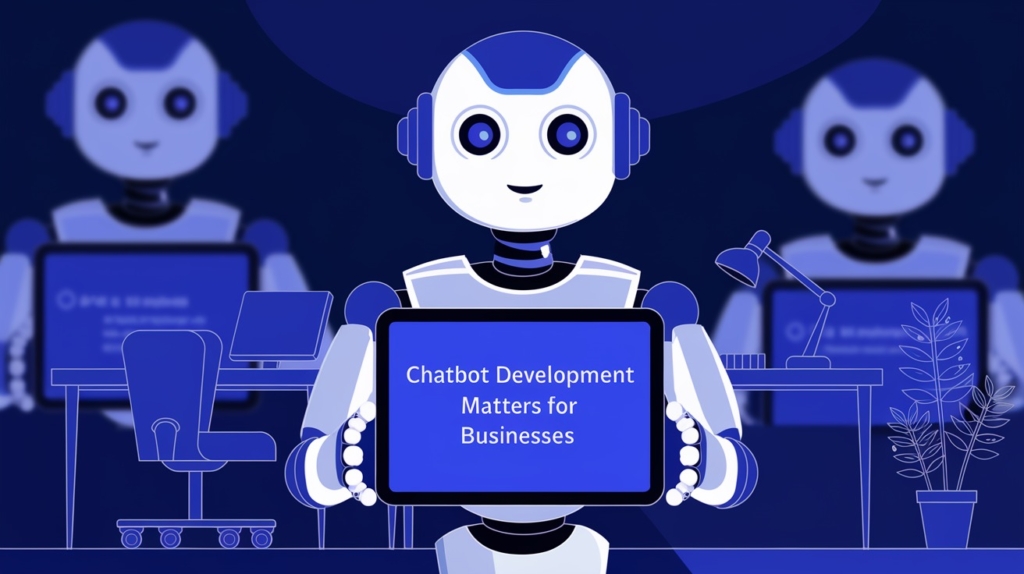Introduction
Chatbots are no longer just a trend—they’ve become essential tools for businesses to stay competitive. From streamlining customer service to driving sales, chatbots have revolutionized how companies interact with their customers. If you’ve been considering implementing a chatbot for your business, you’re on the right path. This blog recaps why chatbot development is so crucial and provides actionable steps to help you take your next leap forward.
By the end of this post, you’ll understand how chatbots can transform your operations and why starting your chatbot development today could be the best decision you make for your business this year.

Why Chatbots Matter to Modern Businesses
They’re Available 24/7
Gone are the days when customers needed to wait hours—or even days—for assistance. With chatbots, your business can provide around-the-clock support. Imagine the impact this has on customer satisfaction. For instance, a customer who has trouble completing an online order at 2 a.m. can get instant help through a chatbot, instead of abandoning their cart.
Streamlined Customer Support
Your customer service team handles countless requests every day. Many of these, like resetting passwords or tracking orders, are repetitive tasks that eat up valuable time. Chatbots can step in to handle these queries, freeing up your team to focus on high-value tasks. The result? A more efficient support operation and happier customers.
For example, brands like Sephora use chatbots to recommend products based on customer preferences, while Domino’s Pizza allows customers to order directly through their chatbot—creating a seamless customer experience and strengthening brand loyalty.
Increased Sales and Lead Generation
Chatbots don’t just answer questions—they sell. By analyzing user behavior and delivering personalized suggestions, they can guide customers through the sales funnel. A chatbot can upsell a product without feeling pushy or help prospects book a free demo of your services.
Statistics back this up. According to a study by FurstPerson, 77% of customers are more likely to purchase after interacting with a chatbot. That’s a massive opportunity your business can’t afford to miss.
Data-Driven Insights
Every interaction your chatbot has with a customer generates valuable data. These insights can help your business understand customer pain points, behavioral trends, and frequently asked questions. Over time, this information sharpens your strategies and enables you to deliver better services.
Platforms like Dialogflow and ChatGPT-powered bots have built-in analytics to help businesses track customer interactions and discover actionable trends.

How Businesses Across Sectors Are Using Chatbots
- E-commerce: Chatbots recommend products, resolve purchase issues, and even send order updates in real time.
- Healthcare: Patients book appointments and access medical advice through AI-powered assistants.
- Banking: Chatbots help customers check balances, transfer money, and resolve account issues, reducing wait times in customer service lines.
- Education: Students get 24/7 access to lesson plans and FAQs, supporting both online learning and traditional classroom settings.
Whether you’re a small business or an enterprise, incorporating a chatbot tailored to your industry can add tremendous value to your operations.
How to Start Your Chatbot Journey
Step 1: Identify Your Goals
Ask your team what problems you want the chatbot to solve. Is it reduced customer support response time? Higher lead conversions? A more seamless sales experience? Clarifying your goals will ensure your chatbot delivers maximum ROI.
Step 2: Choose the Right Platform
Not all chatbots are created equal. Platforms like Chatfuel and ManyChat are ideal for chatbots on social media, while Google Dialogflow excels for natural language processing (NLP) applications.
Step 3: Collaborate with Experts
Custom chatbot development ensures that your bot aligns perfectly with your business needs and brand’s personality. Partnering with developers who understand your industry and goals can make all the difference.
Step 4: Test, Launch, and Improve
Once built, test your chatbot extensively to ensure it works as intended. Roll it out in stages, gather feedback, and use data-driven insights to refine its performance over time.
The Competitive Edge Chatbots Bring
Businesses that integrate chatbots see benefits that go beyond immediate cost savings and customer satisfaction. They build brand loyalty, maintain competitiveness in fast-moving markets, and ensure that no customer inquiry goes unanswered.
But perhaps the most compelling reason to introduce a chatbot right now? Adoption rates are skyrocketing. A report from Gartner predicts that by 2027, chatbots will become the primary customer service channel for over 25% of businesses. Early adopters today can secure a clear competitive edge tomorrow.
Time to Take Action
The case for chatbot development is clear. Whether you want to enhance your customer service, drive sales, or streamline operations, a chatbot can deliver measurable benefits in no time.
If you’re ready to take the next step, we’re here to help. Contact us today to discuss how we can create a chatbot tailored to your business needs. Together, we’ll turn your vision into reality.
